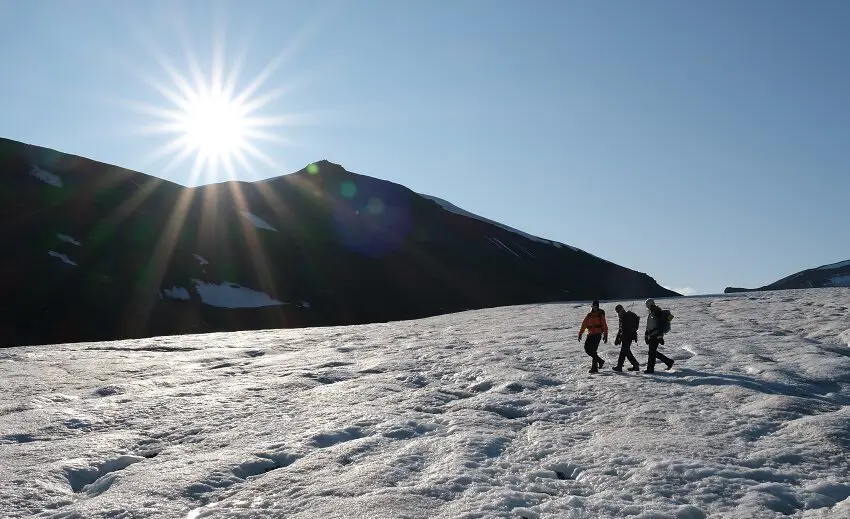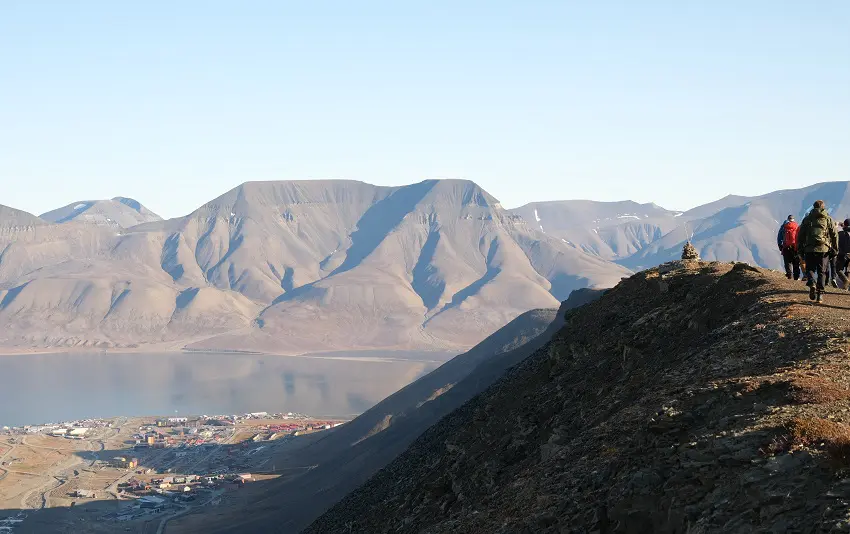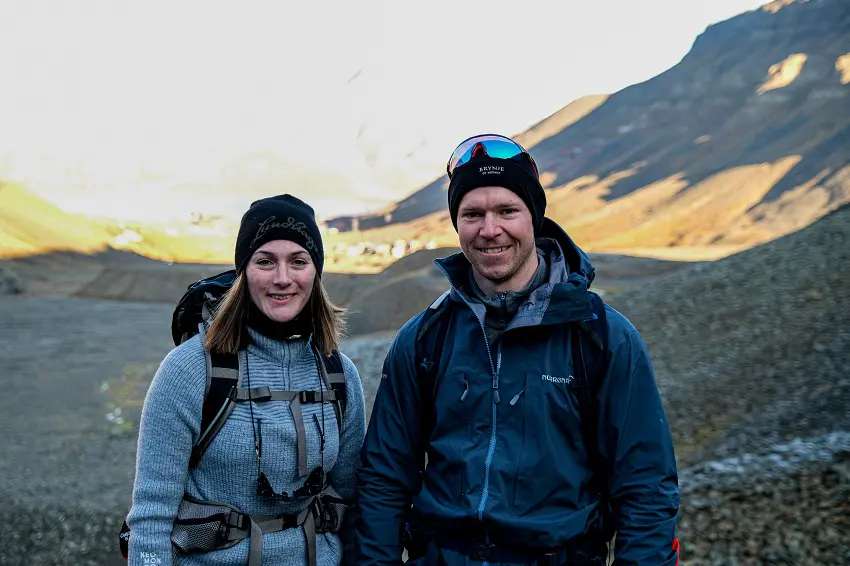Risk assessment in the Arctic

Students returning from Sarkofagen via Longyearbreen. Photo: Maria Philippa Rossi/UNIS
Top image: Students returning from Sarkofagen via Longyearbreen. Photo: Maria Philippa Rossi/UNIS
Students enrolled in Arctic Safety master courses learn to decipher the whimsical Svalbard nature. Their future mission is to keep people and infrastructure safe from natural hazards.
4 November 2021
Text: Maria Philippa Rossi
– What’s different from when we did the risk assessment yesterday?
Martin Indreiten’s voice cuts through the crispy, clear September air. The sky is blue, there is barely a visible cloud, the ground is frozen.
– It’s frozen. The ground is frozen, someone says.
What yesterday were trickles of water coming from Larsbreen is now a thin layer of ice that cracks under the pressure of 15 students.

– Last night we had the season’s first frost. Do we need to change our plans?
Except for being a bit more careful on the icy slopes and give each other a helping hand crossing the now frozen stream, everyone agrees it has the potential to be a perfect field day.
What’s acceptable risk?
The students were gathered for a risk assessment of the fieldtrip the day before. The planned route was to go from Nybyen, via the moraine in Larsbreen to the summit of Sarkofagen and then down via Longyearbreen.
Indreiten points at the risk matrix and explains about mishap probability.
– With the different factors we face, the risk ranges from very unlikely to almost certain. The mishap consequence ranges from simple terrain, challenging terrain and complex terrain, and the injuries from injury unlikely, could severely injure or will kill you.
It’s all about knowing your acceptable risk profile, and determining how safe is safe enough?
– Applying the overall risk assessment to your Acceptable Risk Profile helps determine if the travel decision fit into your group or organisation’s tolerance for risk, Indreiten adds.
Bearable dangers
As the students are asked to evaluate the risks they may face, extremes such as landslides and drowning are mentioned. But overall, the challenges are bearable.
Since we’re in polar bear territory, Indreiten says that an easy extra “safety measure” is bringing more than one rifle. It opens to divide the group if necessary.
– In the planning process you make limitations for what you can and cannot handle. If you bring more weapons, the group can split up if someone needs to turn around. If you bring a crevasse rescue kit and know where the meltwater channels are, you minimize the risk while being on the glacier, Indreiten says.
The students have been in Svalbard for a couple of weeks, but not everyone has gotten to know each other yet.
– What kind of accidents can you handle as a group? It’s useful to map out the resources in the group. Don’t be surprised if the group has a lot of resources! Have you thought about why they do the safety briefs on airplanes? If only 10 % listens, you still have quite a few people who know what to do in an emergency.

UNIS’ approach to safety
Safety in all levels of operation is of utmost importance to UNIS, and as a part of the Arctic Safety studies the students aid in the risk assessment of all UNIS’ activities.
Anna Johansson (29) has studied risk- and environmental studies and is now doing a master in hydrology. With a background in both social and natural sciences she finds the studies in Longyearbyen current and relevant.
– I’ve worked in the building industry, and I’m interested in climate change. Having experience from the Svalbard context is very useful in that way.
Marius Kjeve (29) started a master’s in Societal safety and security. He has worked as a fire fighter in Tromsø and is used to being on the alert. He’s visited Svalbard five times previously, but only in the winter so far, and is excited to explore it during a different time of year.
– It’s good to know that I’m staying for a whole semester and get the chance to explore the wilderness around town. I enjoy being outside, he says.
Satisfied with the course content
The first course they completed was Safety Management in the Arctic, and Marius applauds the lecturers, despite being a relatively new course.
– The lecturers were great. I feel that we are in the middle of our studies. You can sit and read about something, and then go out and see it in context. We’ve been to the site of the 2015 avalanche, and it makes a big difference, he adds.
Anna has always had a wish of exploring the Arctic, and as she landed in Longyearbyen, she felt pure happiness.
– It felt like home! It sounds a bit cliché, but I was bit by the Svalbard bug.
She laughs. And sitting on top of Sarkofagen, eating lunch in calm winds with the sun shining, there’s no reason to question that.
Anna’s passion is water, and she hopes her future career will involve a lot of field work, both administratively and operatively.
– I can see myself working at a government level or project management with risk administration. With the climate change we will probably see more flooding, and that’s my specialty.

Increasing knowledge
At UNIS, all students conduct a safety course to prepare themselves for the potential dangers of going out in the Arctic wilderness.
The Arctic Safety students continues to study what the other students are introduced to, with more examples and analyses of previous event. The last point is an important part of the learning process.
– These are applied subjects, at the same time as the students learn the theory behind it, says Professor Eirik Albrechtsen.
– They learn methods that allow them to work with safety management in all types of companies. In Svalbard they get the Arctic context with climate change and extreme weather conditions. The distance to further help is also an issue in the Arctic. Extra assistance is far away, and we may not have the same access to infrastructure or technology as other places.
Promoting Arctic Safety
Marius explains that a semester in Longyearbyen has given him some unique experiences. He says that the emergencies he prepares for in the Arctic is applicable to the mainland as well.
– We must change the way we think and how we’re used to act. The weather is colder and harsher than what most students are used to, and we need to be prepared for it, Marius says.
– We’ve been hiking around Longyeardalen and seen the safety measures that are implemented, and the natural hazards they are supposed to protect us from. A very important part of risk assessment is planning, and then we can execute the field trips in a safe way.
Students and professors look at the background for why a safety measure is implemented and done that way. Through understanding the theory and knowledge behind the decisions, they help improve risk management at UNIS.
